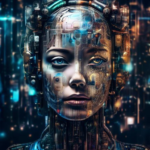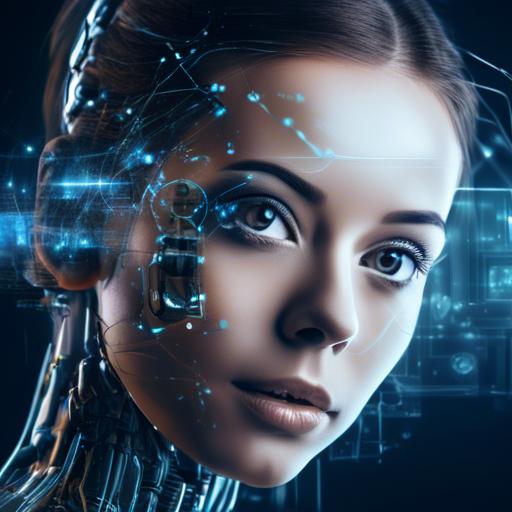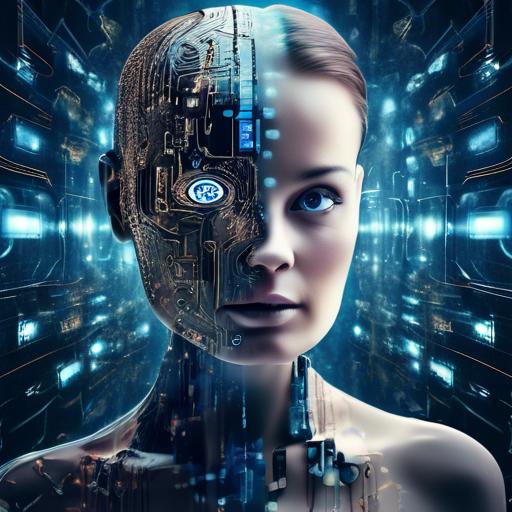In a world where pixels transform into masterpieces and algorithms paint vivid dreams, the realm of machine learning in image generation emerges as a spellbinding confluence of technology and creativity. Imagine an artist that never tires, learns from every stroke, and consistently evolves its techniques. This artist is not human; it’s the prodigious offspring of machine learning and boundless data.
Welcome to a journey where we unravel the mysteries and magic behind this cutting-edge confluence. Whether you’re a curious newcomer or a seasoned technophile, this exploration aims to infuse you with clarity and inspiration. By demystifying the intricate algorithms and celebrating their startling accomplishments, we hope to kindle your fascination and deepen your understanding of how machines are refining, redefining, and revolutionizing the canvas of creativity.
So grab your virtual paintbrush, and let’s dive into the intriguing world of machine learning in image generation, where the only limit is the horizon of imagination.
Table of Contents
- Unveiling the Mystery: What is Machine Learning in Image Generation
- The Crucial Role of Data: Feeding the Machine for Artistic Mastery
- Algorithms at the Helm: How Machines Learn to Create Images
- From Pixels to Masterpieces: Techniques in Image Generation
- The Ethical Canvas: Navigating AI in Art and Creativity
- Balancing Creativity and Control: Setting Boundaries for Machines
- Future Horizons: The Ever-Evolving Landscape of AI in Image Artistry
- In Summary
Unveiling the Mystery: What is Machine Learning in Image Generation
Imagine you have a blank canvas and a magic brush that can paint anything you wish without you lifting a finger. Machine learning in image generation is that magic brush, driven by the prowess of algorithms and data. At its core, it leverages neural networks to learn from a vast array of images, enabling it to recreate, modify, or invent completely new visuals. This fascinating fusion of art and technology has opened the doors to an infinite realm of creative possibilities.
One of the central mechanisms in this process involves **Generative Adversarial Networks (GANs)**, which consist of two neural networks in a symbiotic dance: the generator and the discriminator. The generator’s role is to create images from random noise, while the discriminator evaluates these images against real ones, striving to detect any imperfections. As they continuously challenge each other, the generator improves, producing increasingly realistic images.
Consider the magic of **style transfer**, where an algorithm takes the content of one image and the style of another to craft a unique blend. Ever wondered how your photo would look if Van Gogh had painted it? This technique can transfer the vibrant brush strokes of his masterpieces onto your digital photographs, creating stunning art pieces.
- Deep Dream: This technique intensifies patterns in images, creating dream-like, surreal results.
- Image Inpainting: This involves filling in the missing parts of an image, perfect for restoring old photographs.
- Super-Resolution: Enhancing the resolution of an image, allowing us to zoom in without losing clarity.
| Technique | Application |
|---|---|
| Deep Fake | Creating hyper-realistic digital faces |
| Data Augmentation | Expanding datasets by creating altered versions of images |
| Virtual Try-Ons | Simulating how clothes or accessories look on an individual’s photo |
With these tools and techniques, we are not just enhancing the present; we are fusing creativity with computational power, propelling us into a future where the line between science and art becomes delightfully blurred. Whether you’re an artist, a tech enthusiast, or simply a curious soul, the possibilities are boundless when it comes to machine learning in image generation.
The Crucial Role of Data: Feeding the Machine for Artistic Mastery
In the vibrant realm of image generation via machine learning, **data is the lifeblood** that flows through the algorithmic veins of creative frameworks. Imagine an artist without paint or canvas; similarly, a machine learning model without data is devoid of its artistic capabilities. The richness and diversity of the data fed into these systems are critical for achieving nuanced and sophisticated image outputs.
**How Data Shapes Creativity:**
- The breadth of the data influences the range of styles and subjects the model can handle.
- High-quality, labeled datasets ensure the accuracy and relevance of generated images.
- Innovative data augmentation techniques can enhance the variety and robustness of datasets.
Let’s dig deeper into the types of datasets that empower these models. Here’s a simple breakdown of data categories and their significance in artistic image generation:
| Data Type | Description | Impact |
|---|---|---|
| Annotated Images | Labeled with specific attributes like color, shape, and objects | Enhances precision |
| Diverse Image Sources | Includes various styles, genres, and cultural perspectives | Increases versatility |
| High-Resolution Images | Images with fine details and high clarity | Improves detail and quality |
**Balancing Quantity with Quality:** While an extensive dataset provides a broader learning horizon, the quality of data is paramount. Models trained on skewed, biased, or low-quality datasets may produce inferior and even inappropriate artistic outputs. Data curation should thus be meticulous, ensuring the datasets are representative, comprehensive, and clean.
the data fed into machine learning models acts as both muse and material. It shapes the creative instincts of these digital artists, steering them toward the creation of varied and visually appealing images. By appreciating and harnessing the power of well-curated data, we elevate the artistic capabilities of these cutting-edge technologies.
Algorithms at the Helm: How Machines Learn to Create Images
At the core of image generation through machine learning are algorithms that have developed an uncanny ability to mimic the creative prowess of artists. These algorithms, empowered by vast datasets and intricate neural networks, learn to produce visuals that range from realistic photographs to abstract art. The magic lies in their ability to discern patterns and textures, which they then use to conjure up new images that feel both familiar and novel.
One cornerstone of this technology is the **Generative Adversarial Network (GAN)**, a framework where two neural networks, the generator and the discriminator, engage in a dance of data. The generator creates images while the discriminator judges them, pushing the generator to refine its output until the generated images are indistinguishable from real ones. This dynamic training process can be thought of as a continual game of cat and mouse, with each iteration bringing the algorithm closer to perfection.
| Algorithm | Primary Function |
|---|---|
| GANs | Generate realistic images by pitting two networks against each other. |
| VAE | Create images by encoding and decoding data into a less complex form. |
| PixelRNN | Generate images pixel-by-pixel, capturing local image structure. |
Ahead of the curve in this revolution is **Variational Autoencoders (VAEs)**, another sophisticated approach. VAEs function by compressing the image data into a smaller, latent space, enabling the generation of new images from this condensed representation. Unlike GANs, which focus on adversarial training, VAEs prioritize high-dimensional data compression and reconstruction, making them highly efficient.
Moreover, algorithms like **PixelRNN** offer a unique perspective by generating images one pixel at a time, meticulously capturing the local dependencies. This painstaking approach can yield astonishingly detailed results, although it comes at the cost of higher computational power. The evolution of these algorithms showcases how far we’ve come in enabling machines to capture the essence of visual creativity.
- Real-world Applications: From creating hyper-realistic portraits to enhancing video game graphics, these technologies are revolutionizing the visual arts landscape.
- Ethical Implications: As with all technologies, the ethical use of image generation is paramount to ensure authenticity and prevent misuse.
- Future Trends: The continued integration of AI and machine learning in creative sectors promises ever more sophisticated tools for artists and designers.
From Pixels to Masterpieces: Techniques in Image Generation
Creating stunning images using machine learning isn’t merely about letting an algorithm run wild. The journey from a blank canvas to striking visual art requires intricate techniques and thoughtful design decisions. Whether it’s GANs, VAEs, or other cutting-edge models, each approach offers a unique pathway to artistry. Understanding these techniques can transform our perception of what AI can accomplish in visual creativity.
Generative Adversarial Networks (GANs) are one of the most powerful and widely used methods in image generation. They operate through a fascinating dance between two neural networks: the generator and the discriminator. The generator crafts images from random noise, while the discriminator evaluates their authenticity, driving the generator to create increasingly lifelike images. This adversarial process spawns innovative visuals, showcasing the potential of AI to mimic human creativity.
- Generator: Creates images from random noise.
- Discriminator: Evaluates and distinguishes real images from generated ones.
- Adversarial Training: Both networks improve together, enhancing the realism of generated images.
Variational Autoencoders (VAEs) offer another exciting approach, focusing on the learning of latent spaces. Unlike GANs, VAEs aim to understand the underlying structure of the data by encoding images into a latent space and decoding them back, creating variations that remain true to the original data distribution. This ability to navigate and modify the latent space empowers artists to explore a vast array of creative possibilities with controlled precision.
| Technique | Main Characteristics |
|---|---|
| GANs | Adversarial process, Generator vs Discriminator |
| VAEs | Latent space learning, Encoder-Decoder structure |
For those delving deeper into the pioneering edges of AI-generated art, exploring hybrid models like StyleGAN and BigGAN can unlock unprecedented levels of detail and style customization. These advanced algorithms combine the principles of GANs with additional enhancements, providing better control over attributes such as textures, patterns, and artistic styles. By merging style transfer techniques, artists can infuse AI-generated images with specific artistic sensibilities, borrowing characteristics from renowned human-made artworks.
- StyleGAN: Offers precise control over image styles and attributes.
- BigGAN: Optimized for generating high-resolution and complex images.
By mastering these techniques, anyone can traverse the fascinating frontier where machine learning meets art. Whether through the iterative rivalry of GANs, the structured latent spaces of VAEs, or the refined controls in hybrid models, the toolbox for creating digital masterpieces is vast and continually expanding.
The Ethical Canvas: Navigating AI in Art and Creativity
Machine learning in image generation is reshaping the boundaries of artistic creation. As we delve into this digital renaissance, it’s crucial to understand the frameworks and algorithms that drive these cutting-edge tools. This new era of creativity is powered by neural networks, particularly **Generative Adversarial Networks (GANs)**, which push the frontier of what we consider possible in the visual arts.
At the core of these neural networks lie two components:
- Generator: It creates images from random noise.
- Discriminator: It evaluates the authenticity of these images.
These components work in tandem, engaging in a constant feedback loop to refine and perfect the output. The journey starts with a series of randomized pixels, which the generator molds into increasingly realistic forms as it learns from the discriminator’s critiques.
“Creativity is intelligence having fun” – Albert Einstein. Perhaps nowhere is this truer than in the collaborative dance of neurons and pixels within a GAN.”
One of the most captivating aspects of machine-generated art is its **ability to amalgamate styles and epochs** with astonishing precision. For instance, an AI can merge cubist forms with Renaissance techniques, crafting compositions that challenge traditional aesthetic norms. Yet, while the technology is awe-inspiring, it also raises ethical questions about authorship, originality, and the role of the artist.
| Aspect | Traditional Art | AI-Generated Art |
|---|---|---|
| Creation Time | Weeks to Months | Seconds to Hours |
| Originality | Human Imagination | Data-Driven Fusion |
| Skill Level | Years of Practice | Algorithm Training |
While the allure of instantaneously generated art is potent, the ethical canvas we are painting with AI must be navigated with intention and care. As artists and technologists alike explore these new tools, the dialogue surrounding **ethical AI** becomes ever more pertinent. By embracing both innovation and responsibility, we can ensure that the machine learning renaissance enriches rather than diminishes the human spirit of creativity.
Balancing Creativity and Control: Setting Boundaries for Machines
It’s exhilarating to imagine machines generating stunning visual art with just a trained algorithm, but the freedom of algorithms must be balanced with control to ensure quality and integrity. When machines take on the mantle of creativity, guiding principles become essential. **Setting boundaries** is not about limiting potential, but about channelling it effectively.
- Defining Purpose: Before delving into the creation of image-generation models, understanding the intended use is paramount. Are we aiming for artistic expression, fashion design, or enhancing virtual reality?
- Data Selection: Selecting the right data sources can make or break the creative process. Curate data that reflects the diversity and specificity needed for your goal.
Creating a machine learning model that can produce visually appealing images involves striking a balance between randomness and structured learning. **Hyperparameter tuning** is where this balance can be meticulously adjusted. By carefully setting variables such as learning rate and dropout rates, we can fine-tune the creativity of the algorithm without letting it spiral into chaos.
| Parameter | Description | Impact on Creativity |
|---|---|---|
| Learning Rate | The speed at which the model learns | High rates can lead to over-creative, erratic results |
| Dropout Rate | Percentage of nodes ignored during training | Higher rates encourage diversity in output |
| Batch Size | Number of images processed at a time | Smaller batches enhance granularity in learning |
Effective boundary setting also involves **ethical guidelines**. Trusting machines with creativity comes with the responsibility to avoid biases and unethical reproductions. Enforcing clear policies on data usage and model transparency can mitigate risks. Equally, it’s essential to monitor output for any unintended biases that could taint the creative process.
The synthesis of creativity and control ultimately leads to the development of machines that not only automate but also elevate artistic endeavors. **Encouraging innovation** while adhering to well-framed boundaries creates a harmonious environment where human ingenuity and machine efficiency coalesce. The result? Mesmerizing images that embody both technological prowess and artistic spirit.
Future Horizons: The Ever-Evolving Landscape of AI in Image Artistry
As we tread further into the boundless expanse of AI’s potential in art, the incorporation of machine learning models becomes essential in crafting images that are not just aesthetically pleasing but also inventive. Machine learning, a subset of AI, enables algorithms to learn from data, thereby creating art that evolves and adapts with each new piece of information.
Artists and technophiles alike are drawn to the cutting-edge approach of using neural networks such as Generative Adversarial Networks (GANs) to produce art. With two competing models—one generating images and the other evaluating them—the outcome is a vivid mastery of textures, patterns, and forms previously unimaginable. This process isn’t just about replication; it’s about **innovation in visual storytelling**.
- **DeepDream**: Enhances and generates dream-like, hallucinogenic patterns in images.
- **Neural Style Transfer**: Mixes the content of one image with the style of another to create a unique piece of art.
- **Pix2Pix**: Transforms sketches into realistic images, automatically converting simplistic outlines into lifelike depictions.
This evolving landscape offers groundbreaking tools tailored for various creative needs. Imagine an AI model that can mimic a myriad of artistic styles while maintaining a level of creativity. The future horizon promises personalized AI artists that can cater to individual tastes, perpetually learning and adapting from each project.
| Tool | Function | Impact |
|---|---|---|
| DeepDream | Pattern enhancement | Surreal visuals |
| Neural Style Transfer | Content-style blending | Fusion artwork |
| Pix2Pix | Sketch transformation | Realistic renderings |
The possibilities are endless when these technologies are combined with **creative intuition**. Machine learning in image artistry is not merely an adjunct to traditional methods but a revolutionary force that redefines how we perceive and create art. Whether for pragmatic design tasks or ethereal, avant-garde expressions, AI continues to push the boundaries, opening new horizons for artistic exploration.
In Summary
As you embark on your journey to understand machine learning in image generation, remember that the possibilities are endless. With patience, dedication, and a thirst for learning, you can unlock the full potential of this incredible technology. So, embrace the challenges and celebrate the victories as you delve deeper into the world of machine learning. Your creativity and innovation have no limits. Keep pushing boundaries, creating beauty, and transforming the way we see the world. The future is in your hands – go forth and create wonders!
































